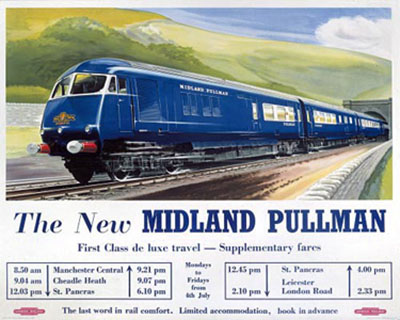Blue Pullman
LMR Publicity

Left: At the launch of the Pullman service (LMR) the LMR produced a chrome-litho poster in nine colours from a design by Mr A. N. Wolstenholmes, showing a set travelling at speed through typical Derbyshire countryside, a design that was used in other places.
They also produced a 12 page brochure, with a high standard of printing and with colour and b/w pictures. It contained many facts thought to be of "interest to the diligent traveller".

There was brief details of the train itself, timings, notes on the St Pancras to Manchester line and the Pullman Car Co. Ltd., with some illustrations of Pullman cars on the Midland Railway in early days. The coloured frontispiece used the same artwork as the poster, and chief places on the Midland route to Leicester and Manchester were shown in a coloured pictorial map. The pleasing gilt cover bore the arms of the County of London and of the City of Manchester. The full brochure can be seen on the next page.


On the left can be seen a more basic advert, on on the right another poster (larger version can be found on Getty Images).
The British Transport Commission Film Unit made a film 'Blue Pullman' and this was awarded first prize in the Technical & Industrial Information section of the Festival for Films for Television held Rome in 1961.
The film, produced by Edgar Anstey and directed by James Ritchie, covered the story of the units from prototype testing to inauguration. Although it was essentially a documentary, there were plenty of human touches and all the personnel, scientists, engineers, crew and Pullman staff got equal credit for the success of the train. The film was in excellent colour, and by putting it on general release the BTC showed the public not only what was being done by way of providing first-class train services, but also demonstrated how much care and painstaking research was involved before a new train could be passed as suitable for service.
(This film, as well as another Film Unit one showing a WR run and an excellent film made by Met-Camm showing the construction of the sets have been released on a single video/dvd). Details on the British Transport Film website).
Summary
Development
Press run 24/6/60
Press run 7/9/60
Staff difficulties
Ownership agreement
Manufacturer's Publicity
Description
Type 1 - LMR motor car
Type 2 - WR motor car
Type 3 - WR parlour 2nd car
Type 4 - LMR kitchen car
Type 5 - WR kitchen car
Type 6 - LMR/WR parlour 1st car
Interior
Air conditioning
Motor cars
Auxiliary power
Bogies & couplings
Brakes
Data
Sub contractors
Staff instructions
LMR services begin
LMR Publicity
LMR brochure
LMR handbills
Controversy
WR services begin
WR publicity
WR publicity brochure
WR publicity leaflet
LMR Operations
WR Operations
Liveries
Rundown & withdrawal
After service & preservation
Disposal
Maintenance Manuals
Miscellaneous
Acknowledgments & Further Reading
Images
No vehicles were preserved.


